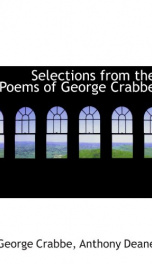Crabbe George
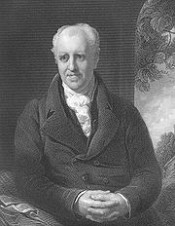
George Crabbe (24 December 1754 – 3 February 1832) was an English poet and naturalist. He was born in Aldeburgh, Suffolk, the son of a tax collector, and developed his love of poetry as a child. In 1768, he was apprenticed to a local doctor, who taught him little, and in 1771 he changed masters and moved to Woodbridge. There he met his future wife, Sarah Elmy, who accepted his proposal and had the faith and patience not only to wait for Crabbe but to encourage his verse writing. His first major work, a poem entitled "Inebriety", was self-published in 1775. By this time he had completed his medical training, and had decided to take up writing seriously. In 1780, he went to London, where he had little success, but eventually made an impression on Edmund Burke, who helped him have his poem, The Library, published in 1781. In the meantime, Crabbe's religious nature had made itself felt, and he was ordained a clergyman and became chaplain to the Duke of Rutland at Belvoir Castle in Leicestershire. The two works for which Crabbe became best known were The Village (1783) and The Borough (1810), both lengthy poems dealing with the way of life he had experienced. In 1783, he also married Sarah. In 1814, he became Rector of Trowbridge in Wiltshire, where he remained. By the time of his death, he was well-regarded and a friend of William Wordsworth, Sir Walter Scott and other major literary figures of the time. Benjamin Britten's opera Peter Grimes is based on The Borough. Byron, an avowed admirer of Crabbe's poetry, called him "Nature's sternest painter, yet the best". Crabbe's poetry was predominantly in the form of heroic couplets.[2] His poetry has also been described as unsentimental in its depiction of provincial life and society.[3] He was also an active and notable coleopterist and recorder of beetles, and is credited for taking the first specimen of Calosoma sycophanta L. to be recorded from Suffolk. He published an essay on the Natural History of the Vale of Belvoir in John Nichols's, Bibliotheca Topographia Britannica, VIII, Antiquities in Leicestershire, 1790. It includes a very extensive list of local coleopterans, and references more than 70 species. This text was later reviewed by the renowned entomologist Horace Donisthorpe (Leics. lit. phil. Soc., 4, 1896, 198-200), who concluded that George Crabbe had both a broad knowledge of national species and was well acquainted with contemporary scientific literature, including works by Linnaeus and Fabricius.
do you like this author?
What readers are saying
What do you think? Write your own comment on this book!
write a commentWhat readers are saying
What do you think? Write your own comment on this author!
write a commentBook list

the life and poetical works of the rev george crabbe
Series:
Unknown
Year:
Unknown
Raiting:
3/5
Show more
add to favoritesadd In favorites
Book list

the life and poetical works of the rev george crabbe
Series:
Unknown
Year:
Unknown
Raiting:
3/5
Show more
add to favoritesadd In favorites
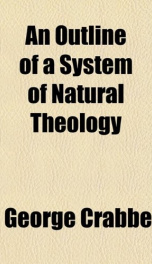
an outline of a system of natural theology
Series:
Unknown
Year:
Unknown
Raiting:
2.5/5
Purchase of this book includes free trial access to www.million-books.com where you can read more than a million books for free. This is an OCR edition with typos. Excerpt from book: 40 CHAPTER II. Section I.Physical Proofs of the Beginning of the present Order of Nature on this Planet. A DETAILED proof of a beginning of the present course of nature, will, doubtless, appear to a reader imbued with the truths of revelation, and unmindful of the principles of our opponents, to be a very superfluous labour; but we have to reply to those who admit not the evidence of revelation: and when that source of our knowledge is closed by the very nature of the inquiry, it becomes necessary to rest on some other very solid foundation. The natural proof of a beginning of the present phenomena of matter was, till very lately, extremely unsatisfactory, being chiefly metaphysical : and Paley completely fails, as was observed in the Introduction, in the evidence of this very important point. But the recent discoveries in geology have afforded us physical proofs of a commencement of organic existence, and of the present and past disposition of the crust of the earth: nor am I aware that this conclusion of the geologists (according with every explanation of the Mosaic statements) has been lately disputed. Nevertheless, the natural proof must not be omitted. The value of such evidence (in a natural point of view) is indeed incalculable; for it forms a solid basis for the inferences on which the conclusion is built; and this will appear, if we reflect how difficult would be the proof of the independence of a system, exhibiting evidences of an eternal rotation of the same phenomena. The following are the physical proofs of a beginning, and of the gradational evolution of the present system. First: The shape of this globe is just such an oblate spheroid as would be produced by its revolving on its axis at some former period in a fluid or semi-fluid state,fluid t...
Show more
add to favoritesadd In favorites
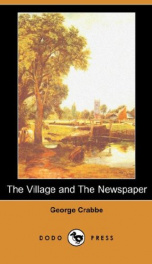
The Village and the Newspaper
Series:
Unknown
Year:
Unknown
Raiting:
4.5/5
George Crabbe was an English poet and naturalist. He was born in Aldeburgh, Suffolk, and developed his love of poetry as a child. By the time he went to London, he had little success, but eventually got the chance to have his poem, The Library, published in 1781.
Show more
add to favoritesadd In favorites
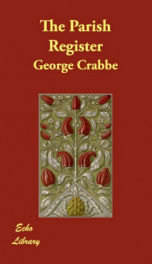
The Parish Register
Series:
Unknown
Year:
Unknown
Raiting:
3.5/5
George Crabbe was an English poet and naturalist. He was born in Aldeburgh, Suffolk, and developed his love of poetry as a child. By the time he went to London, he had little success, but eventually got the chance to have his poem, The Library, published in 1781. --This text refers to an alternate Paperback edition.
Show more
add to favoritesadd In favorites
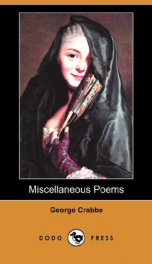
Miscellaneous Poems
Series:
Unknown
Year:
Unknown
Raiting:
3/5
George Crabbe was an English poet and naturalist. He was born in Aldeburgh, Suffolk, and developed his love of poetry as a child. By the time he went to London, he had little success, but eventually got the chance to have his poem, The Library, published in 1781.
Show more
add to favoritesadd In favorites
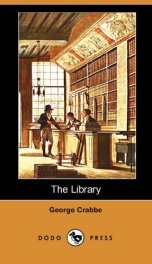
The Library
Series:
Unknown
Year:
Unknown
Raiting:
3/5
George Crabbe was an English poet and naturalist. He was born in Aldeburgh, Suffolk, and developed his love of poetry as a child. By the time he went to London, he had little success, but eventually got the chance to have his poem, The Library, published in 1781.
Show more
add to favoritesadd In favorites
What readers are saying
What do you think? Write your own comment on this author!
write a commentif you like Crabbe George try:
readers also enjoyed
What readers are saying
What do you think? Write your own comment on this author!
write a commentGenre
if you like Crabbe George try:
readers also enjoyed
Do you want to read a book that interests you? It’s EASY!
Create an account and send a request for reading to other users on the Webpage of the book!
